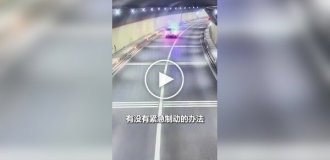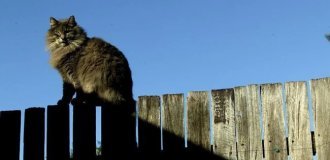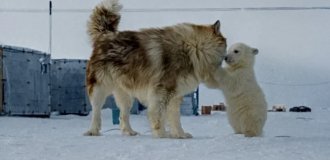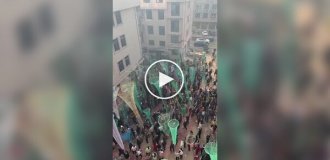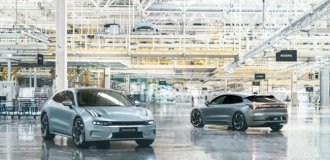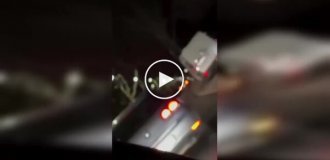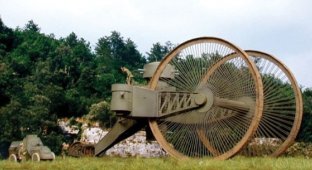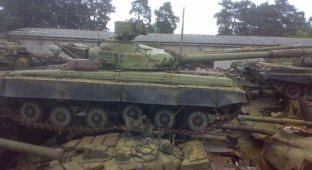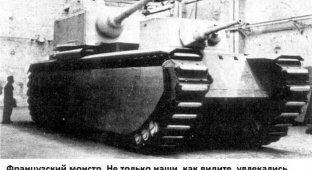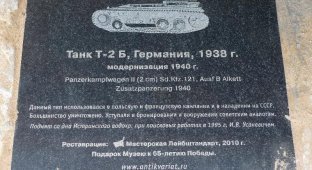IS-1 and IS-2
The IS-1 and IS-2 heavy tanks owe their appearance largely to the KV-1 heavy tank and the KV-13 medium tank with heavy armor. The main incentive for the development of new tanks was the appearance of new German Tiger tanks on the Eastern Front in the winter of 1942-1943. It was their appearance that forced the Soviet leadership to initiate the production and state testing of two experimental Joseph Stalin tanks - IS. The latest versions of the KV-13 were used as chassis, but the armament of the two models was different. Tests of the two tanks took place from March 22 to April 19, 1943 and were considered successful. The State Commission noted that as a result of a denser layout than the KV-1s, the IS tanks have a lower mass of 44 and 46 tons, stronger armor and greater speed.

IS-1
The IS-1 was actually a deep modernization of the KV-1 tanks. Its weapons and armor protection were significantly redesigned. The tank received a new gearbox, while the IS-1 had a large number of parts from KV tanks of various modifications. The layout of the car was classic. Its armored hull was divided from bow to stern into a control compartment, a combat compartment and an engine-transmission compartment. In the first there was a mechanic driver, the other three crew members occupied jobs in the fighting compartment, which combined the tank turret and the middle part of the armored hull. A gun was installed here, ammunition and part of the fuel tanks were located. The transmission and engine were located at the rear of the tank.
The armored body of the vehicle (with the exception of the frontal part) was welded from armor plates with a thickness of 90, 75, 60, 30 and 20 mm. The frontal part of the streamlined body was cast; in different parts its thickness varied from 30 to 120 mm; it was connected to other parts by welding. The tank's streamlined turret was an armor casting of complex geometric shape. The thickness of its sides was 100 mm. The sides were located at an angle to the vertical, which increased projectile resistance.
The main weapon of the tank was the D-5T cannon of the 1943 model, which had a caliber of 85 mm. The gun was mounted on axles in the turret and was completely balanced. The tower was also balanced, its center of mass was on the geometric axis of rotation. The gun's ammunition consisted of 59 unitary loading shots. The shells were placed in the tank's turret and along both sides of the fighting compartment. This gun was a tank version of the 52-K anti-aircraft gun. A total of 130 IS-1 tanks were produced.

The main vehicle that bore the brunt of the fighting in the last years of the war was the IS-2, which was also called the IS-122, in this case the number 122 denoted the caliber of the tank gun. A total of 3,475 tanks of this modification were produced. The idea to equip the tank with more powerful guns was dictated by necessity. The 85-mm D-5T cannon mounted on the IS-1 did not have sufficient capabilities to combat the new German medium Panther tanks and heavy Tiger tanks. In addition, the 85-mm projectile had a low high-explosive effect to combat enemy pillboxes and bunkers.
As a result, it was decided to equip the IS tank with a 122-mm gun, developed on the basis of the A-19 gun. This artillery piece was modified for installation in a tank. In particular, it received a muzzle brake that softens recoil, a more compact recoil device, and improved placement of controls to provide the gunner with more comfortable conditions when working in a confined space of the turret. The revised version of the gun received the designation D-25T. The gun's ammunition consisted of 28 separate-loading shots. Due to this fact, as well as the large weight of the shells, the gun's rate of fire was 3 rounds per minute, and even less in combat conditions. However, when hitting the target, a shell fired from this gun often pierced German tanks or led to the collapse of the turret. The gun also performed well during the assault on German cities, which the Nazis turned into real fortresses.
Another significant difference between the IS-2 tank and the IS-1 was the change in the frontal part of the hull. In order to improve projectile resistance, the IS-2 model of 1944 was equipped with a new “straightened” frontal armor piece. Instead of a streamlined stepped tip of a complex geometric shape, the IS-2's forehead began to be equipped with flat armor plates, the top of which looked like a trapezoid tapering towards the tank turret, was located at an angle of 60°, and its thickness reached 120 mm.
IS-3
The IS-3 was a further development of the series; it appeared at the very end of the Great Patriotic War and did not take part in hostilities. This vehicle is most often considered the first Soviet post-war heavy tank. The main distinguishing feature of the tank is its characteristic frontal part - the nose of the hull, which looked like a pike, and the tank itself was nicknamed “Pike” for it.
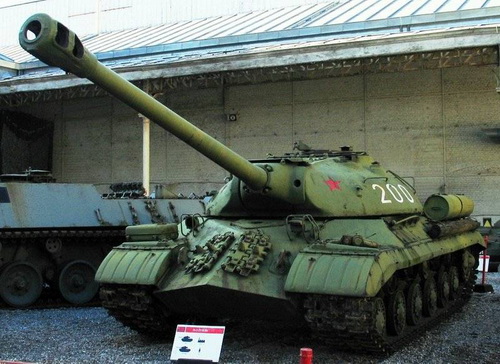
The development of the tank took place in 1944, the first batch was manufactured in May 1945. Serial production of the vehicles continued until mid-1946, with a total of 2,311 tanks produced. The tank had a classic layout; its crew consisted of 4 people. The tank was armed with the same 122-mm D-25T gun as on the IS-2 tank. At the same time, the tank received a new turret of a flattened design, which was subsequently used on all Soviet tanks from T-54 to T-90.
The IS-3 had very strong differentiated anti-ballistic armor and was designed to protect against all modern tanks and anti-tank guns in the frontal projection and against the impact of most tanks and anti-tank guns from the sides. The front of the tank was armored with 110 mm. armor plates, according to the scheme called “pike nose”. The front of the hull consisted of two plates that converged like a wedge, located with an inclination of 56° to the vertical. The armor of the sides reached 90 mm, with an armor slope of 60°; in addition, the upper part of the sides was covered with 30 mm screens. The tank's turret was a casting of homogeneous armor and had a flattened hemispherical shape. The thickness of its walls ranged from 220 mm at the base to 110 mm at the top; the front of the tower had armor close to 255 mm. At the same time, the mass of the tank remained at 46 tons.
It is noteworthy that the IS-3, which did not take part in the war, became a participant in the Berlin Parade of the Allied Forces, dedicated to the victory in World War II. On September 7, 1945, 52 IS-3 tanks drove through the streets of Berlin and made a strong impression on our allies in the anti-Hitler coalition.
IS-4 and IS-5
The IS-4 Soviet heavy tank, adopted for service in 1947, was produced from 1947 to 1948 in a fairly small series of 219 units. It was a further development of the IS-2 tank. The main focus was on increasing bookings. The armor on the front of the hull and sides of the tank reached 160 mm. The armor of the turret in the front part reached 250 mm, on the sides - 200 mm. Such an increase in armor could not but affect the weight of the combat vehicle. The maximum weight of the tank approached 60 tons, which required the installation of a new V-12 engine with a power of 750 hp; previous models of the tank were equipped with engines with a power of 520 hp.
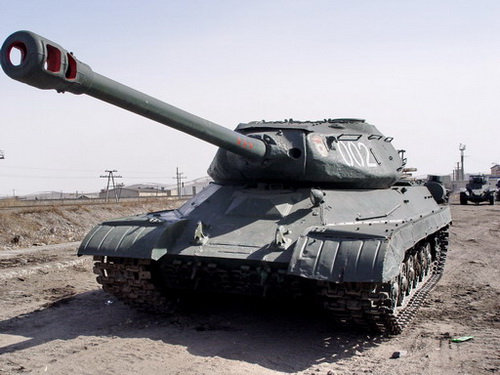
IS-4
The IS-5 was a prototype tank that never went into production. Its main difference was the 100-mm S-34 cannon, which never proved its reliability during testing. As a result, the IS-4 went into production, armed with the old, proven 122-mm D-25T gun, while the tank’s ammunition capacity reached 30 rounds (increased by 2).

IS-5
During operation, it turned out that the tank, due to its mass, cannot be crossed over many bridges and faces difficulties in transportation by various vehicles. In addition, a number of shortcomings of its transmission and its lack of reliability were revealed. At the end of the 1970s, all tanks of this series were sent for melting down.
IS-6
The IS-6 is an experimental Soviet tank, but was not accepted for service. Development of the tank began in 1943. The preliminary design of the vehicle was carried out from December 1943 to the summer of 1944. In total, two options were proposed - “Object 252”, which had a mechanical transmission of the same type as the IS-3, but using large diameter road wheels. There were no support rollers.
A feature of another tank, the Object-253, was an electromechanical transmission, which was supposed to have a positive effect on maneuverability and make the tank easier to control. The chassis was similar to that of the IS-2 tank. During testing, the experimental vehicles were inferior to the IS-4 tank sent into production.
IS-7
An experienced Soviet heavy tank, developed in 1945-1947, the total number of vehicles produced did not exceed 50 units. One of the most powerful tanks of its time and the heaviest among Soviet tanks, it was not accepted into service with the army. This tank was in many ways a development of the IS-3 tank, and was distinguished by the use of a number of technical solutions that were far ahead of its time. It had a classic layout. At the same time, the tank's crew increased to 5 people, and a second loader appeared in its composition.

IS-7 in the museum in Kubinka
The tank inherited from the IS-3 the frontal part of the hull, made according to the pike nose design, while its armor was significantly increased. The hull forehead and sides were 150 mm thick. The turret's forehead was 210 mm thick, the gun mantlet was 350 mm thick, and the turret's side armor reached 150 mm. The combat weight of the tank reached 68 tons, while the latter could reach a speed of 60 km/h on the highway. This was largely due to the new M-50T diesel engine with a power of 1050 hp; this engine was a variant of a marine diesel engine. It is noteworthy that this was not the only part that the tank received from the fleet.
The main armament of the tank was a 130-mm S-70 rifled cannon, with a barrel length of 57.2 calibers and an initial velocity of 33.4 kg projectile at 900 m/s. This gun was developed on the basis of a 130 mm naval gun. The gun was equipped with a vertical wedge semi-automatic bolt, with the help of which the rate of fire was increased to 6-8 rounds per minute. When firing, the tank's control system automatically aimed the gun, guided by the position of the sight, and fired a shot. Tank ammunition included 30 rounds of separate loading.
T-10 (IS-8)
The last heavy tank of the IS series. Serially produced from 1954 to 1966. In total, from 2,500 to 8,000 of these tanks were produced. It was in service with the Soviet army for 40 years, but was withdrawn from service with the Russian army in 1993. The tank was designed to replace the IS-2 and IS-3 that were in service; during its development, the operating experience of the IS-4 and IS-7 was taken into account, which led to a reduction in the weight of the tank to 50 tons. The decrease in the tank's weight was accompanied by a decrease in its armor level. During design, the tank received indices from IS-8 to IS-10, but after Stalin's death the tank received a new name T-10.

Like the IS-3 and IS-7 tanks, this tank had a “pike nose” but less modest armor compared to the latter. The front of the hull had armor of 120 mm, sides of 80 mm, front of the turret - 201 mm, sides of 148 mm. Initially, the tank was equipped with an improved D-25TA gun, inherited from the IS-2 and IS-4 tanks, as well as a V-12-5 diesel engine with a power of 700 hp.
At the same time, the overwhelming number of tanks in service had the T-10M index, and in the 60s, all vehicles produced were improved to this modification. In it, the tank received a new 122-mm M-62-T2 gun, which was distinguished by high ballistics and a 2E12 Liven two-plane stabilizer. Instead of the DShK, a 14.5 mm KPVT machine gun was installed on the tank, the design of the turret was changed, and its frontal armor was increased to 250 mm. The tank received a new, more powerful V12-6 engine with a power of 750 hp, anti-nuclear protection and a set of night vision devices for all members of the tank crew, with the exception of the loader.
